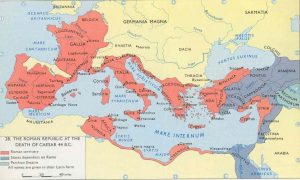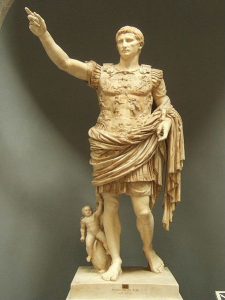As I made my way through the second season of Netflix’s Roman Empire (reviewed last week), a line from its narrator (the always delightful Sean Bean) brought me up short. Describing Rome in the middle of the first century BC, the show states that “Rome was not yet an empire, but a Republic.” I snorted with laughter; an old nemesis of mine had reared its ugly head yet again. In an effort to perhaps lessen the spread of this idea, I took to my keyboard in an attempt to explain exactly why I was so bitterly amused, and in so doing shed light on one of the more misunderstood aspects of Roman history: the stages of its government.

Rome as Kingdom, 753 BC – 509 BC — From its founding, traditionally placed in 753 BC, Rome was a kingdom. It’s first king (Latin rex) and mythical founder, Romulus, was supposedly succeeded by six other monarchs. Roman kings ruled like any other ruler of that moniker, combining ultimate political, military, and religious authority in one figure. These six named kings are likely partly or wholly mythical, especially as each has a themed list of accomplishments for Rome. The destruction of Rome’s records in 390 BC when the city was sacked by marauding Gauls makes it very difficult to determine the historical reality behind these stories, but Romans were certain about two things: the last, tyrannical, king was overthrown in 509 BC by the Roman people and, ever after, to say someone was acting like a king was meant as a grave criticism of that person’s hunger for power.

Rome as Republic, 509 BC – 27 BC — After the overthrow of the last Roman king, the people of Rome founded the Republic (Latin res publica, or ‘public entity), giving more authority to the pre-existing Senate, originally just a council of elders. The powers of government were split between priests and the legislature, and the citizens of Rome were organized into voting ‘tribes’ to elect public offices. Senators, however, were unelected; admission to the august body was based on property and experience. The Republic was the longest-lived stage of Roman government, and naturally went through many changes in its nearly five-century run. However, even at its most radical, the Roman Republic was neither democratic nor representative; it was an oligarchy, controlled by the ultra-wealthy patrician families that made up the Senate and priestly castes. It was also in this period that Rome began to expand beyond its own walls, and thus became an empire. It is ridiculous to tie empire-hood to the presence of a single, autocratic ruler, and the Republic’s drive to dominate first it’s immediate neighbors, then all Italy, and finally the entire Mediterranean made it an empire long before the civil wars that resulted in what has traditionally become known as the formal Roman Empire.

Rome as Principate, 27 BC – AD 284 — The final outcome of the civil wars between first Julius Caesar and Pompey Magnus and then Marc Antony and Octavian left the Republic battered, the authority of the Senate broken, and the entirety of Rome’s military power in the control of one man. Leveraging his newly-consolidated authority, Octavian was declared the head of the Roman state, took on the name Augustus, and began the era of the Roman Empire. This terminology, however, is very misleading. Not only had Rome been an empire for centuries already, but Augustus was never called any Latin word resembling ‘emperor,’ nor did he assume total authority over the Roman state. In an effort to placate the Senate and avoid being seen as another king, Augustus took the title princeps senatus, princeps civitatis (Latin, ‘first among senators, first among citizens’) and preserved many of the less important functions of Republican government. This relationship was more akin to an absolute monarch with a symbolic representative body than a constitutional monarchy, however; all the real power lay with Augustus and his successors.

Rome as Dominate, AD 284 – AD 476 — The third century AD saw Rome wracked with crisis after crisis, and the empire at times looked to be close to falling apart from incessant infighting. Rome endured, however, and a series of reforms by Diocletian transformed the Principate into the more absolutist Dominate, from the ruler’s new title of dominus (Latin, ‘master’). The Dominate was the most authoritarian of all Roman stages of government, and would remain the model of rule until the fall of the Western Empire. The Dominate only provided stability for a short period, however, and most of its two centuries would be dominated by civil wars and the decline of both Roman territorial power and imperial authority in the West.
As you can see, the Roman state is not so easily defined, and certainly is more complex than a simple dichotomy between ‘Republic’ and ‘Empire.’ Given the inspiration the Founding Fathers took from Rome in constructing the United States’ own government, not to mention the strong cultural and intellectual influences Rome still holds in Western civilization, it remains vitally important to understand this thousand-year state on its own terms, exploring the specific conditions of its governance and dispelling these commonly-held misconceptions about so seminal a period of history.
